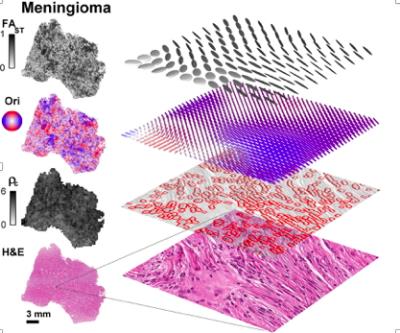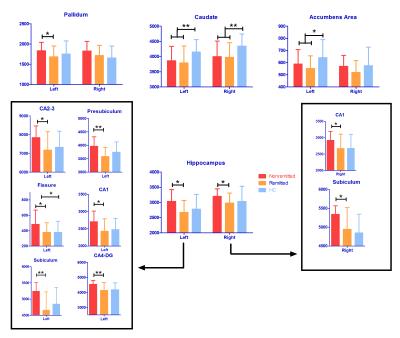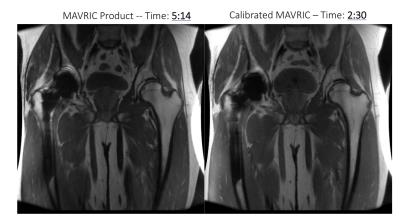Studying Value of MRI
Electronic Poster
Ad Hoc
Tuesday, 25 April 2017
| Exhibition Hall |
17:15 - 18:15 |
| |
|
Computer # |
|
4446.
 |
97 |
A clinically-validated, fast and semi-automated MR workflow for Liver Evaluation 
Qingsong Yang, Yukun Chen, Caixia Fu, Bernd Kuehn, Berthold Kiefer, Zhen Wang, Xu Yan, Chao Ma, Dehe Weng, Luguang Chen, Jianping Lu
A fast and semi-automated MRI workflow for liver examinations with approximately 12mins of total examination time was proposed and evaluated with liver patients using CT or histo-pathology as reference. 28 patients suspected of liver disease were enrolled in this study. The results show a good concordance between findings on MRI and the chosen reference standard. This indicates that the proposed fast MRI workflow has the capability to be used for diagnostic purposes in clinical routine while being highly time efficient at the same time.
|
|
4447.
 |
98 |
Increasing value of MRI in evaluation of gynecologic malignancies by decreasing scan time and reducing artifacts through the replacement of fast spin echo (FSE) with variable refocusing flip angle single-shot FSE (vrfSSFSE) - video not available
Paul Stoddard, Valentina Taviani, Daniel Litwiller, Michael Muelly, Shreyas Vasanawala, Andreas Loening
Variable refocusing flip angle single-shot fast spin echo (vrfSSFSE) with outer volume suppression (OVS) improves upon standard single-shot fast spin echo (SSFSE or HASTE): 1) decreasing average flip angles thereby reducing specific absorption rate (SAR) limited acquisition times, 2) reducing blurring from T2 decay, 3) allowing full-Fourier acquisitions. Although improving upon conventional SSFSE, it remains unknown if vrfSSFSE with OVS can approach the image quality and diagnostic capability of fast spin echo (FSE). We found vrfSSFSE comparable to FSE in signal-to-noise and contrast and superior to FSE in coherent artifact reduction, depending on the plane of imaging.
|
|
4448.
 |
99 |
Robust high-throughput Cardiac MR featuring Compressed Sensing - permission withheld
Michaela SCHMIDT, Peter WEALE, Kavin JAYAWARDHANA, Christoph FORMAN, Sue THOMAS, Carmel HAYES, Russell Bull
A standard CMR protocol for the evaluation of cardiac function and myocardial damage in patients with ischemic or non-ischemic heart-disease was compared to a new approach which drastically reduces the scan time. This was achieved by introducing a highly accelerated compressed sensing cine sequence which facilitated significant work-flow optimization. Image quality scores of both methods were equivalent and quantitative results showed good agreement. The mean examination time was reduced from 26:29 ± 5:45 min to 16:15 ± 2:47 min, which corresponds to a 38 % reduction in examination time.
|
|
4449.
 |
100 |
Gradient Echo vs. Spin Echo MRI to Determine Liver Iron Concentration 
Arthur Wunderlich, Holger Cario, Mario Teigeler, Meinrad Beer, Stefan Schmidt
To evaluate an alternative to an established method for liver iron content (LIC) determination based on spin-echo (SE) MRI, we analyzed 195 MRI scans, including both SE and gradient echo (GRE) protocols, of regularly transfused patients suspected for liver iron overload. A relationship was derived between reference LIC obtained by Ferriscan® and GRE data. From this, LIC was determined using GRE acquisitions and these values correlated to reference LIC. Considering the LIC threshold of 80 µmol/g (4.5 mg/g) relevant for therapy, diagnostic accuracy of the GRE approach was quite good, with sensitivity and specificity of 99/98 % compared to Ferriscan®.
|
|
4450.
 |
101 |
Development of an artificial intelligence algorithm to automatically assign MR abdomen/pelvis protocols from free-text clinical indications. 
Jae Ho Sohn, Joseph Mesterhazy, Fouad Al Adel, Thienkhai Vu, Alex Rybkin, Michael Ohliger
Timely and accurate MR protocoling is important to ensure best efficiency and diagnostic value in radiology departments. We propose and validate an artificial intelligence based natural language classifier that can assign MR abdomen/pelvis protocols based on free-text clinical indications. We achieve an overall classification accuracy rate of 93% on a test set consisting of 83 free-text clinical indications.
|
|
4451.
 |
102 |
Mapping cell shape and cell density by diffusion variance decomposition (DIVIDE): Towards rapid non-invasive diagnostic and prognostic assessment of tumors 
Danielle van Westen, Filip Szczepankiewicz, Karin Bryskhe, Pia Sundgren, Markus Nilsson
In this work we present a novel approach based on tensor-valued diffusion encoding to quantify tumor tissue characteristics such as cell shape and cell density variation — features considered in histopathology. This approach constitutes a promising framework for non-invasive diagnostic and prognostic assessment of tumors that may improve patient care by non-invasively capturing histopathological information on cell shape and cell density heterogenity.
|
|
4452.
|
103 |
Limited MRI protocol for ischemic stroke 
CC Tchoyoson Lim, Wai Yung Yu, Francis Hui, Wing Lok Au, Yih Yian Sitoh
We describe adapting a Limited Stroke Protocol of unenhanced MRI pulse sequences (including diffusion-weighted images to diagnose recent cerebral infarction and TOF MR angiography to detect large intracranial vessel stenosis/occlusion), for hospital inpatients and the Emergency Room patients with suspected recent ischemic stroke. Although this abbreviated, targeted limited MRI protocol may be challenging in subtle diagnosis, it improves patient access, enables image-guided decision-making, and results in rapid throughput.
|
|
4453.
 |
104 |
Diagnostic value of using SSFP and UTE subtraction MRI for the management of critical limb ischemia patients 
Trisha Roy, Howard Chen, Andrew Dueck, Graham Wright
There are two treatment options for revascularizing patients with critical limb ischemia: bypass surgery and percutaneous vascular intervention (PVI). PVI is less invasive but has high immediate technical failure rates (20%) and high re-intervention rates (20%). The most common mode of immediate failure is the inability to enter/cross the lesion. With current imaging (X-ray angiography, CTA, Duplex ultrasound) it is difficult to predict which lesions will be soft enough to cross with a wire to make PVI possible. Physicians have responded with a “percutaneous-first” strategy where they attempt PVI in all patients and perform surgery if PVI fails. This requires more procedures per index limb at significant cost to healthcare systems and delays definitive revascularization. Additionally, there is evidence that surgical bypass after failed PVI results in worse outcomes, including higher amputation rates within 1 year. These issues highlight the critical need for improved diagnostic accuracy to inform patient selection. We have developed and validated MR methods to distinguish hard PAD lesions (densely calcified or collagenous) that would be at high risk of PVI failure from soft lesions that would be amenable to PVI. The impact of this work will help to reduce PVI failure rates, reduce time to definitive revascularization and reduce costs for additional procedures and investigations.
|
|
4454.
 |
105 |
Can replacement sagittal diffusion images increase MR value of spinal imaging in patients with suspected malignant disease? 
Saurabh Singh, Timothy Bray, Alan Bainbridge, Magdalena Sokolska, Shonit Punwani, Margaret Hall-Craggs
To increase the MR value of spinal imaging in patients with suspected or known malignant disease, we propose the use of sagittal diffusion weighted imaging as replacement for traditional image types such as STIR and T2W TSE. The impact of this protocol is threefold. Scan times are reduced from potentially 50 minutes to 15 minutes for the whole spine; making scans more tolerable for patients with back pain, reducing cost and increasing scanner capacity. Reader confidence is increased in detecting malignant infiltration especially when diffuse. Finally, read times are reduced as there are fewer images to review.
|
|
4455.
 |
106 |
MR arthrography of the hip using 3D isotropic SPGR reconstructed with ESPIRiT compressed sensing reconstruction and two-point Dixon fat-water separation 
Kathryn Stevens, Tao Zhang, Marcus Alley, Shreyas Vasanawala
A single volumetric SPGR sequence reconstructed with ESPIRiT compressed sensing reconstruction and two-point Dixon fat-water separation was added to routine hip MR arthrogram and compared to the conventional 3-plane 2D-FSE fat-saturated T1-weighted sequences in identification of hip pathology in 25 patients. SPGR compared favorably well with T1 FS, but failed to identify 3 subtle labral tears, 1 chondral delamination and 3 low-grade ligamentum teres tears, possibly due to increased blurring associated with SPGR, decreasing overall image quality of SPGR. The relative time saving of SPGR and ability to subsequently reformat data makes this a viable technique for hip MR arthrograms.
|
|
4456.
 |
107 |
USPIOs for metastatic lymph node detection in prostate cancer: back on the block 
Tom Scheenen, Ansje Fortuin, Janine van der Linden, Ilia Panfilov, Bas Israel, Roger Brüggeman, Jelle Barentsz
The presence of nodal metastases in patients with prostate cancer is a key factor determining prognosis and treatment. With the reintroduction of ferumoxtran-10-enhanced MRI in local clinical practice, small metastases in lymph nodes down to 2 mm in size can be detected non-invasively, avoiding diagnostic surgical lymph node dissections and guiding personalized treatment of patients with prostate cancer at intermediate and high risk for metastatic spread.
|
|
4457.
 |
108 |
Whole-body MRI for initial assessment of plasma cell disorders including multiple myeloma 
Arash Latifoltojar, Margaret Hall-Craggs, Alan Bainbridge, Neil Rabin, Ali Rismani, Rakesh Popat, Kwee Yong, Shonit Punwani
Whole body MRI (WB-MRI) is increasingly being used to assess plasma cell disorders (PCDs). The adoption of WB-MRI provides a niche to further incorporate novel imaging technique into assessment of PCDs, streamlining decision making progress in a cost-effective way.
|
|
4458.
 |
109 |
Quality Assessment in the Multicenter MR Imaging Study of the German National Cohort (NAKO) 
Jochen Hirsch, Alexander Köhn, Daniel Hoinkiss, Jonas Singe, Eyyub Öztürk, Matthias Günther, the NAKO MRI Study Investigators
A fully automated workflow for image-based quality assessment (QA) was set up in a large, multi-center cohort whole-body MR imaging study, part of the National Cohort Study Germany NAKO. Study design, data management, workflow, and objectives have been described previously. Standardized quality assessment including technical aspects like program and protocol parameter truth, as well as image-based estimates of various quality indices demonstrate a high degree of stability and homogeneity of image quality across the 5 contributing MR centers. Furthermore, QA ensures short-term intervention procedures with respect to quality control, and offer valuable quantitative information for subsequent scientific data evaluation.
|
|
4459.
|
111 |
MRI evaluation of suspected appendicitis in pediatric patients 
Christina Sammet, Cindy Rigsby, Barb Karl, Laura Gruber, Jie Deng
Appendicitis is prevalent in pediatric populations and currently CT imaging is used to triage children to emergency surgery. As of early 2015 we have been able to replace this CT scan with a limited abdomen/pelvis study using MRI. This limited MRI appendicitis protocol is rapid, cost-neutral (equal in cost to our previous CT study for appendicitis), and confers less potential risk to the child by eliminating radiation exposure. Using state-of-the-art rapid MRI imaging techniques, we have been successful in imaging suspected appendicitis in children as young as five years old.
|
|
4460.
 |
112 |
Using Hippocampus Volume to Predict Treatment Outcome in Major Depressive Disorder 
Xiaoxiao Hu, Lianqing Zhang, Ming Zhou, Lu Lu, Xinyu Hu, Qiyong Gong, Xiaoqi Huang
The current study aimed to use structural data of hippocampus volume obtained from magnetic resonance imaging to predict treatment outcome in major depressive disorder. Our findings demonstrated that there was a relationship between left hippocampus volume and medication efficiency in major depressive disorder group. Meanwhile, our results threw light on the predictive value as a marker of treatment responsiveness in major depressive disorder.
|
|
4461.
 |
113 |
Voxel-wise meta-analysis of resting-state functional activity in type 2 diabetes 
Taiyuan Liu, Jia Liu, Wenhui Wang, Lun Ma, Xiaoyue Ma, Shaojie Shi, Qiyong Gong, Meiyun Wang
Previous studies about resting-state functional activity reported that altered brain activity was demonstrated with type 2 diabetes and their findings were inconsistent ,which have not been quantitatively reviewed. Therefore, we conducted a quantitative meta-analysis including resting-state functional activity studies of patients with type 2 diabetes. Meta-analysis of pooled and subgroup meta-analyses found that type 2 diabetes patients showed abnormal brain activity mainly in default mode network(DMN) and visual-related regions. Our finding supports that type 2 diabetes could lead to diabetic brain activity alterations, which may correlate with cognitive impairment of type 2 diabetes patients.
|
|
4462.
|
114 |
Simultaneous Perfusion Imaging with Consecutive Echoes (SPICE) 
Michael Schmainda
SPICE (simultaneous perfusion imaging with consecutive echoes) is a method that permits simultaneous estimation of DSC- and DCE-MRI parameters, in one acquisition, using a single dose of contrast agent. Conventional algorithms are used to obtain the perfusion and permeability parameters corrected for confounding recirculation and leakage e?ects. The proposed method does not require administration of a loading dose of contrast agent (traditionally employed for DSC), and pre-contrast spin density and native T1 calibration scans (traditionally required for DCE) have been eliminated.
|
|
4463.
 |
115 |
Open Source Imaging Initiative (OSI²) – Update and Roadmap 
Felix Arndt, Sebastian Aussenhofer, Eva Behrens, Christian Blücher, Peter Blümler, Janko Brand, Kate Ettinger, Ariane Fillmer, William Grissom, Bernhard Gruber, Bastien Guerin, Sergej Haas, Haopeng Han, Michael Hansen, Christopher Hasselwander, Russ Hodge, Werner Hoffmann, Bernd Ittermann, Marcin Jakubowski, Andre Kühne, Stefan Klein, Stefan Kroboth, Mark Ladd, Kelvin Layton, Brian Leiva, Sebastian Littin, Blanca López-Aranguren Blázquez, Kasper Marstal, Ralf Mekle, Manuel Moritz, Raphael Moritz, Thoralf Niendorf, Ruben Pellicer, Mihir Pendse, Athanasios Polimeridis, Tobias Redlich, Henning Reiman, Reiner Seemann, Frank Seifert, Ludger Starke, Jason Stockmann, Tony Stoecker, Kazuyuki Takeda, Lukas Thiele, Martin Uecker, Florian von Knobelsdorff-Brenkenhoff, Robert Wahlstedt, Andrew Webb, Simone Winkler, Lukas Winter, Huijun Yu, Maxim Zaitsev
*authors are listed in alphabetical order The aim of the open source imaging initiative (OSI²) is to collaboratively share research in MR technology and building a quality, affordable open source MR scanner. Combining innovation and open source (OS) approaches will generate global value by reproducible science and development and will allow a major reduction of investments and operational costs with the guiding principle: From the community, for the community. OSI² (www.opensourceimaging.org) was presented for the first time at the ISMRM 2016. Here we present an update and a roadmap towards the fulfillment of our vision.
|
|
4464.
 |
116 |
Clinical Impact of Reduced Spectral Acquisitions in Calibrated 3D Multi-Spectral Imaging Near Metal Implants 
Rajeev Mannem, Sujan Fernando, Sean Lehner, Suryanarayanan Kaushik, Kevin Koch
We present the clinical evaluation results of a novel approach for acquisition time reduction in 3D multispectral imaging near implants. Two musculoskeletal radiologists compared standard MAVRIC SL sequences to spectrally calibrated MAVRIC SL sequences for exams of instrumented hips, knees, and shoulders. Initial results demonstrated maintenance of diagnostic information in the hips when the calibration is utilized. Rotator cuff evaluation was still limited in the shoulder using the calibrated technique but evaluation of the other structures was nearly equivalent. Calibrated imaging of the knee showed reductions of SNR, which will inform future adjustment of targeted calibrated protocols in this joint.
|
|
















